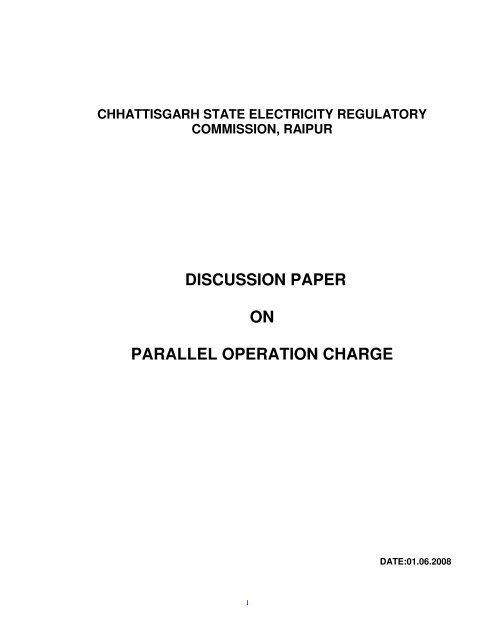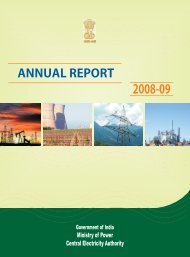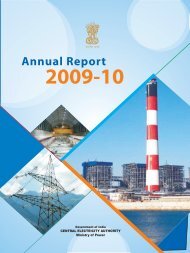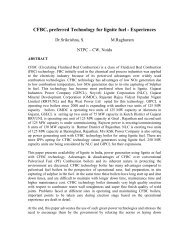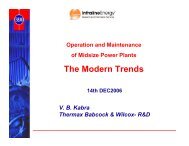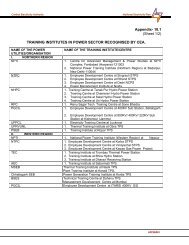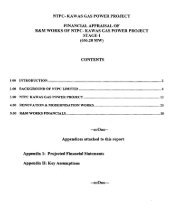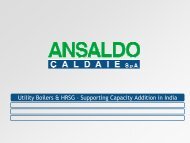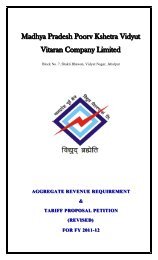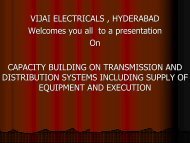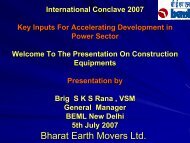discussion paper on parallel operation charge - Infraline
discussion paper on parallel operation charge - Infraline
discussion paper on parallel operation charge - Infraline
Create successful ePaper yourself
Turn your PDF publications into a flip-book with our unique Google optimized e-Paper software.
CHHATTISGARH STATE ELECTRICITY REGULATORY<br />
COMMISSION, RAIPUR<br />
DISCUSSION PAPER<br />
ON<br />
PARALLEL OPERATION CHARGE<br />
DATE:01.06.2008<br />
1
1. BACKGROUND<br />
CSEB filed before the Commissi<strong>on</strong> its first tariff applicati<strong>on</strong> for determinati<strong>on</strong> of ARR and tariff<br />
under Secti<strong>on</strong> 62 of the Electricity Act,2003(the Act) and other miscellaneous and general<br />
<strong>charge</strong>s under Secti<strong>on</strong> 45 and 46 of the Act. In additi<strong>on</strong> to revisi<strong>on</strong> of the rates of various<br />
services rendered by the Utility, the Utility had proposed to levy stand-by <strong>charge</strong>s <strong>on</strong> the<br />
Captive Power Plants (CPPs) running in <strong>parallel</strong> with the CSEB’s Grid at the rate of 7.5% of<br />
demand <strong>charge</strong>s <strong>on</strong> the installed capacity of the CPP, in view of the benefits enjoyed by the<br />
CPPs running in <strong>parallel</strong> with grid and the intangible services being rendered by the CSEB.<br />
In its first tariff order, the Commissi<strong>on</strong> fixed various miscellaneous and general <strong>charge</strong>s, as<br />
proposed by the Board which were based <strong>on</strong> the rates then prevailing in MPSEB, which had the<br />
same rates before bifurcati<strong>on</strong> of the erstwhile MPEB, as requisite significant data input was a<br />
c<strong>on</strong>straint. However in case of <strong>parallel</strong> operati<strong>on</strong> <strong>charge</strong>s, the Commissi<strong>on</strong> fixed Rs. 16 per kVA<br />
<strong>on</strong> the installed capacity of the CPPs, which was less than that of the Board’s proposal.<br />
While disposing off the petiti<strong>on</strong> No. 17 of 2005 (M), in the matter of power purchase and related<br />
dispensati<strong>on</strong> in respect of Captive Generating Plants, the Commissi<strong>on</strong> passed an order <strong>on</strong><br />
06.02.2006 wherein various issues were addressed in light of the provisi<strong>on</strong>s of the Act, Nati<strong>on</strong>al<br />
Electricity Policy and Tariff Policy. Keeping in view of the objecti<strong>on</strong>s of the CPPs, the<br />
Commissi<strong>on</strong> reduced the <strong>parallel</strong> operati<strong>on</strong> <strong>charge</strong>s to 60% of the approved <strong>charge</strong> i.e., Rs. 10<br />
per kVA per m<strong>on</strong>th till the rate was reviewed and revised, if necessary, in the next tariff order <strong>on</strong><br />
the basis of a realistic study.<br />
The Urla Industries Associati<strong>on</strong>, the petiti<strong>on</strong>er in petiti<strong>on</strong> No. 17 of 2005, preferred an appeal<br />
(No. 99 of 2006) before the H<strong>on</strong>’ble Appellate Tribunal for Electricity (ATE) against the Order<br />
passed by the Commissi<strong>on</strong>.<br />
The directi<strong>on</strong>s of the H<strong>on</strong>'ble Appellate Tribunal for Electricity in their judgement of 12th<br />
September 2006 passed in appeal no. 99 of 2006 are as follows:<br />
"The c<strong>on</strong>tenti<strong>on</strong> that no <strong>charge</strong>s at all is payable for <strong>parallel</strong> operati<strong>on</strong> or transmissi<strong>on</strong><br />
system can not be sustained and such a claim is c<strong>on</strong>trary to factual positi<strong>on</strong>. There is no escape<br />
of CPP to pay <strong>charge</strong>s for <strong>parallel</strong> operati<strong>on</strong> by which the CPP gains while the transmissi<strong>on</strong><br />
system of the sec<strong>on</strong>d resp<strong>on</strong>dent CSEB is affected apart from the admitted fact the<br />
transmissi<strong>on</strong> grid is strengthened by the power injected by CPP. However, we make it clear that<br />
in the tariff petiti<strong>on</strong> which is pending c<strong>on</strong>siderati<strong>on</strong>, the Commissi<strong>on</strong> may fix the <strong>charge</strong>s for<br />
<strong>parallel</strong> operati<strong>on</strong> <strong>on</strong> the basis of the data, materials and scientific inputs relating to <strong>parallel</strong><br />
operati<strong>on</strong> <strong>charge</strong> already placed by the parties or that may be placed by the parties before the<br />
c<strong>on</strong>clusi<strong>on</strong> of hearing and such exercise shall be carried out by the first resp<strong>on</strong>dent Regulatory<br />
Commissi<strong>on</strong> independently and without in any manner being influenced by this judgment."<br />
2
By the time this judgement was received, the tariff order for the year 2006-07 was passed by the<br />
Commissi<strong>on</strong> <strong>on</strong> 13 th September 2006.The Commissi<strong>on</strong> hence registered a suo-motu petiti<strong>on</strong><br />
No. 39 of 2006 for determinati<strong>on</strong> of <strong>parallel</strong> operati<strong>on</strong> <strong>charge</strong>s proposed to be levied <strong>on</strong> captive<br />
power plants operating in <strong>parallel</strong> with the CSEB grid. Notice was issued to the CSEB for<br />
submissi<strong>on</strong> of proposal in light of the H<strong>on</strong>’ble Appellate Tribunal’s judgement. M/s BALCO<br />
Limited, M/s Bajrang Power and Ispat Limited, M/s Jayaswal Neco Ltd. al<strong>on</strong>gwith Urla Industries<br />
Associati<strong>on</strong> were made parties as co-resp<strong>on</strong>dents who were also parties to the earlier petiti<strong>on</strong><br />
No. 17 of 2005 (M) filed in the Commissi<strong>on</strong>. During the course of hearing, Urla Industries<br />
Associati<strong>on</strong> and M/s Jaiswal Neco Ltd. pleaded that before final decisi<strong>on</strong> <strong>on</strong> <strong>charge</strong>s towards<br />
<strong>parallel</strong> operati<strong>on</strong> is taken by the Commissi<strong>on</strong>, it would be advisable to go in for a technical<br />
study. The Commissi<strong>on</strong> also felt that a detailed study needs to be carried out as the various<br />
inputs received from the parties, although valuable, do not help the Commissi<strong>on</strong> much in<br />
quantifying justifiable <strong>charge</strong>s for <strong>parallel</strong> operati<strong>on</strong>. The Commissi<strong>on</strong> accordingly ordered <strong>on</strong><br />
11.07.2007 to seek assistance of a technical c<strong>on</strong>sultant for quantifying the benefits drawn by the<br />
CPPs as well as CSEB and to study the disturbances created in the system and also for<br />
quantifying the compensati<strong>on</strong> which the CSEB should get by way of <strong>parallel</strong> operati<strong>on</strong> and<br />
related matters. In the light of the above decisi<strong>on</strong> of the Commissi<strong>on</strong>, the assignment was<br />
awarded to M/s Electrical Research & Development Associati<strong>on</strong>, Vadodara, <strong>on</strong>e of the leading<br />
research organisati<strong>on</strong> in the field of power, through competitive bidding process covering<br />
evaluati<strong>on</strong> of <strong>parallel</strong> operati<strong>on</strong> <strong>charge</strong>s in the scope of study.<br />
2. INTRODUCTION<br />
Electrical power is recognized as a basic input to the ec<strong>on</strong>omic growth and development of the<br />
country. After independence, with the thrust given to power development in the five-year plans,<br />
the extent and reach of electricity has underg<strong>on</strong>e dramatic changes. With thrust <strong>on</strong> programme<br />
for rural electrificati<strong>on</strong> and large scale energizati<strong>on</strong> of pumpsets from 3 rd five year Plan <strong>on</strong>wards,<br />
the sub-transmissi<strong>on</strong> and distributi<strong>on</strong> networks expanded rapidly.<br />
The demand for electricity increased am<strong>on</strong>g all the categories of c<strong>on</strong>sumers, industrial sector<br />
being the largest secti<strong>on</strong> of c<strong>on</strong>sumers of electricity in India. The use of electricity in most<br />
industries increased due to rapid industrial growth. Even if new floor area is not added, more<br />
intensive manufacture within a given area increases the amount of electricity c<strong>on</strong>sumpti<strong>on</strong> by 3<br />
to 5 per cent a year. Our ec<strong>on</strong>omy is rapidly expanding. C<strong>on</strong>sumers including bulk c<strong>on</strong>sumers<br />
are demanding quality, low cost, uninterrupted and reliable electric power to meet their service<br />
3
needs. The electric power utility is undergoing rapid changes due to the emergence of a<br />
competitive envir<strong>on</strong>ment.<br />
Presently there is a shortage of power in India due to the gap between generati<strong>on</strong> and demand.<br />
In Chhattisgarh State there was a shortage of both energy as well as demand. The shortage of<br />
power resulted in power cut <strong>on</strong> the bulk c<strong>on</strong>sumers. Hence many bulk c<strong>on</strong>sumers started<br />
setting up Captive Power Plants for their use encouraged with the liberal provisi<strong>on</strong>s of the Act<br />
(Secti<strong>on</strong> -9) and the Nati<strong>on</strong>al Electricity Policy with a view to not <strong>on</strong>ly securing reliable, quality<br />
and cost effective power but also facilitating creati<strong>on</strong> of employment opportunities through<br />
speedy and efficient growth of power industry. These bulk c<strong>on</strong>sumers with captive power plants<br />
have since reduced their c<strong>on</strong>tract demand with utility to pay minimum as fixed <strong>charge</strong>s per<br />
m<strong>on</strong>th <strong>on</strong> the reduced c<strong>on</strong>tract demand. Most of the captive power plants however, c<strong>on</strong>tinued to<br />
operate their plants in <strong>parallel</strong> with the utility grid.<br />
Parallel operati<strong>on</strong> is an electrical activity where <strong>on</strong>e electrical system is allowed to operate with<br />
c<strong>on</strong>nectivity to another system at the similar operating c<strong>on</strong>diti<strong>on</strong>s. In this process, the power<br />
system operate in tandem with all the c<strong>on</strong>nected generators for better operati<strong>on</strong>al efficiency and<br />
ease. However, the captive generating stati<strong>on</strong>s can also run their plant in islanding mode<br />
without having any c<strong>on</strong>nectivity with grid.<br />
The CSEB in its tariff petiti<strong>on</strong> for the year 2005-06 submitted <strong>on</strong> 11.03.05 has given the<br />
following justificati<strong>on</strong>s for levy of <strong>parallel</strong> operati<strong>on</strong> <strong>charge</strong>s:<br />
The industries having captive power plants are keeping less c<strong>on</strong>tract demand with utility and the<br />
services provided by the utility are much higher than the revenue collected from such<br />
c<strong>on</strong>necti<strong>on</strong>s. More so the energy supplied to such industries is cross subsidizing. The services<br />
provided by utility to CPP are not accounted for and result in loss of revenue to the utility in spite<br />
of having made huge investment for laying the infrastructure.<br />
2.1 POWER SUPPLY STATUS IN CHHATTISGARH:<br />
CSEB is an integrated utility for generati<strong>on</strong>, transmissi<strong>on</strong>, distributi<strong>on</strong> and supply of electricity in<br />
the state of Chhattisgarh. CSEB was created <strong>on</strong> November 15, 2000 when the new State of<br />
Chhattisgarh was carved out of the erstwhile State of Madhya Pradesh. CSEB is the state<br />
Generati<strong>on</strong> & Transmissi<strong>on</strong> Utility and a deemed licensee in the State for electricity distributi<strong>on</strong>.<br />
CSEB has a total installed capacity of 1423.85 MW; comprising 1280 MW thermal, 6 MW of cogenerati<strong>on</strong><br />
and 137.85 hydro generati<strong>on</strong>s. NTPC has an installed thermal capacity of 2100<br />
MW. Apart from NTPC and CSEB, there are number of private generati<strong>on</strong> units of large and<br />
small capacity. The Board has added 500 MW of thermal generati<strong>on</strong> capacity by<br />
4
commissi<strong>on</strong>ing two new units of 250 MW each at Korba East in the year 2007-2008. Thus the<br />
installed capacity of CSEB became 1923.85 MW at the end of year 2007-2008 increasing the<br />
thermal generati<strong>on</strong> to 1780 MW.<br />
The additi<strong>on</strong>al thermal power plants are planned in the State of which some power plants shall<br />
be in the central sector. Most of these plants are in various stages of implementati<strong>on</strong>. The<br />
details of the plants and their installed capacity are given in the table - I below:<br />
Table-I<br />
Name of Plant FY 2005-06<br />
(Total)<br />
FY 2006-07<br />
(Total)<br />
FY 2007-08<br />
(Total)<br />
Korba East TPS PH3,<br />
4units (50MW each)<br />
200.00 200.00 200.00<br />
Korba East TPS PH 3,<br />
2 units (120 MW each)<br />
240.00 240.00 240.00<br />
Korba West TPS,<br />
4 units (210 MW each)<br />
840.00 840.00 840.00<br />
Korba Eest TPS,<br />
2 units (250 MW each)<br />
-- -- 500.00<br />
Total (Thermal) 1280.00 1280.00 1780.00<br />
Total (Hydro & Others) 120.85 143.85 143.85<br />
Total Installed Capacity 1400.85 1423.85 1923.85<br />
Total power generati<strong>on</strong> capacity available in Chhattisgarh is given in table – II below :<br />
Table-II<br />
Sr. No. Particular Capacity in MW<br />
1 CSEB 1923.85<br />
2 Captive power plants 2253.69 (Share of CG is 227.25 MW )<br />
3 Bio-mass generators 131.40<br />
4 IPPs 335<br />
5 Central sector (NTPC) 2100 (Share of CG is 450 MW )<br />
6 TOTAL 6743.94 (Available for state 5093.94)<br />
2.2 EXISTING STATUS OF CPP:<br />
The capacity of CPP in the state of Chhattisgarh has increased substantially <strong>on</strong>ly after formati<strong>on</strong><br />
of the State. As <strong>on</strong> March’08, out of 46 CPPs existed in the State, 35 CPPs are operating their<br />
plant in <strong>parallel</strong> with CSEB having c<strong>on</strong>nectivity to its grid. M/s BALCO, Korba and M/s Jindal<br />
Steel and Power Ltd are the major c<strong>on</strong>tributors with a installed capacity of 810 MW and 347.7<br />
MW respectively. The total installed capacity of these CPPs is 2440.00 MVA and total c<strong>on</strong>tract<br />
for selling to CSEB is 227.25 MW. Total demand c<strong>on</strong>tracted by these CPPs with CSEB is<br />
492.57 MVA. The details of 35 nos. of CPPs are given in table-III below:<br />
5
Sl.No.<br />
Name of C<strong>on</strong>sumers<br />
(CPPs)<br />
Locati<strong>on</strong><br />
Table-III<br />
Interc<strong>on</strong>necti<strong>on</strong><br />
Voltage in<br />
KV<br />
Installed<br />
Capacity<br />
(MVA)<br />
C<strong>on</strong>tract<br />
Demand<br />
(CD) in<br />
MVA<br />
Sale<br />
C<strong>on</strong>tract<br />
with<br />
CSEB<br />
(MW)<br />
1 M/s BALCO, Korba Korba 220 993.088 120 45<br />
2 M/s Arasmeta, Champa Janjgir 132 57.75 3.125 7<br />
3 M/s M.S.P.,Raigarh Raigarh 33 30 2.9 1<br />
4 M/s JSPL,Raigarh Raigarh 220 364.625 1 70<br />
5 M/s Singhal Ent.,Raigarh Raigarh 33 20 3.75 8<br />
M/s Nav Durga Fules,<br />
6 Raigarh Raigarh 33 5 1.6 2<br />
7<br />
M/s Ind Agro<br />
Synergy,Raigarh Raigarh 33 20 2.5 6<br />
8<br />
Shri Radhe Ind.<br />
Ltd.,Bilaspur Bilaspur 33 10 0.8 1.5<br />
9<br />
M/s Crest Steel & Poer<br />
Ltd. Durg 33 13.33 4.5 3<br />
10 M/S Bhilai Electic Supply Bhilai 220 0 0 0<br />
11 M/sPrakash Industry ltd Champa 132 98.15 19.5 0<br />
12 M/S Lafarge S<strong>on</strong>adih 132 22.5 0 0<br />
13 M/s Ultratech cement Raipur 132 38.2 25 0<br />
14 M/s M<strong>on</strong>net Power Raipur 132 72.375 2 12<br />
15 M/s Grasim Cement Raipur 132 22.5 18 0<br />
16 M/s Jaiswal Neco Raipur 132 26.875 8 8.5<br />
17 Sarda Energy. Raipur 33 77.5 5 5<br />
18 Century Cement Baikunth 132 19.625 6 0<br />
19 ACC Jamul Jamul 132 25 1 2<br />
Madhya Bharat Paper<br />
20 Mill Champa 33 3.33 2.5 -<br />
21 Godawari Ispat Raipur 132 106.25 4 5<br />
22 M/S shri Bajrang Power Raipur 132 22.5 1.1 1.5<br />
23 Vandana Global Raipur 132 51.25 4 12<br />
24 Real Ispat & Power Raigarh 132 15 12 5.5<br />
25 Nakoda Ispat Ltd Raipur 33 7.5 3.5 2.75<br />
26 S.K.S .Ispat Raipur 132 68.75 10 10<br />
27 Indsil Energy Raipur 33 15 3.75 1<br />
28 Heera Ferro Unit-II Raipur 33 25 1.8 4<br />
29 Bhilai Steel Plant Bhilai 220&132 142.9 216 0<br />
6
Sl.No.<br />
Name of C<strong>on</strong>sumers<br />
(CPPs)<br />
Locati<strong>on</strong><br />
Interc<strong>on</strong>necti<strong>on</strong><br />
Voltage<br />
Installed<br />
Capacity<br />
(MVA)<br />
C<strong>on</strong>tract<br />
Demand<br />
(CD)<br />
Sale<br />
C<strong>on</strong>tract<br />
with<br />
CSEB<br />
(MW)<br />
30 M/s HEG Ltd.,Borai Borai 33 16 2.75 1.5<br />
API Ispat & Power<br />
31 Ltd.,Siltara Raipur 33 10 2 6<br />
32<br />
Mahendra Sp<strong>on</strong>ge &<br />
Power Pvt.Ltd Raipur 33 10 1.3 3<br />
33<br />
M/s Rashmi Sp<strong>on</strong>ge Ir<strong>on</strong><br />
Pvt.Ltd. Raipur 33 10 0.95 1<br />
34 M/s G.R. Sp<strong>on</strong>ge Pvt.Ltd. Raipur 33 10 0.95 1<br />
35 Vasvani Industry Raipur 33 10 1.29 2<br />
2440.00 492.57 227.25<br />
3.0 PROMOTIONAL POLICY<br />
There are ample examples, where large quantities of low cost waste heat or by-product fuel are<br />
available from which the industrial plant can generate low-cost electric power. Typical of such<br />
industries are large integrated steel mills which burn the excess blast-furnace gas for the<br />
generati<strong>on</strong> of electric power. In some cases where loads are very large (50,000 kW or more),<br />
load factor is high, and low-cost fuel is available, captive power generati<strong>on</strong> has been chosen by<br />
the industrial plants, when power was not readily/fully available at reas<strong>on</strong>able price from the<br />
electric utility. Typical of such cases are the aluminum-process plants, chemical plants, steel<br />
mills and other industries requiring large quantities of electric power. Where such type of<br />
c<strong>on</strong>diti<strong>on</strong>s exist, it is required to study cost of generating a part or all of the power requirements<br />
within the industrial plant. The most ec<strong>on</strong>omical arrangement is often to generate <strong>on</strong>ly such<br />
power as can be made from the process heat or as can be generated from by-product fuel and<br />
to purchase the remainder power.<br />
The State Government of Chhattisgarh has had a positive approach to encourage CPPs in the<br />
new State. A set of policy directives were issued by the Chhattisgarh Government <strong>on</strong> 12.07.02<br />
(Notificati<strong>on</strong> No. 2714/Sec/Energy Deptt/dated 12.7.02) with a view to encourage establishment<br />
of Captive Power Plants. As per these policy directives, CPPs could be set up by any new<br />
industry or existing industries undertaking expansi<strong>on</strong> of capacity for generati<strong>on</strong> of electricity to<br />
meet their own requirements. The utility was given the authority to permit setting up of CPP up<br />
to 25 MW capacity and in c<strong>on</strong>sultati<strong>on</strong> with Central Electricity Authority for any capacity above<br />
that. The CPPs under this policy were not permitted to sell electricity to any c<strong>on</strong>sumer (third<br />
party); they were, however, allowed to sell excess power outside the State, as well as the State<br />
utility.<br />
7
As per Electricity Act 2003, a pers<strong>on</strong> may c<strong>on</strong>struct, maintain or operate generating plant and<br />
dedicated transmissi<strong>on</strong> lines provided that the supply of electricity from the captive generating<br />
plant through the grid shall be regulated in the same manner as the generating stati<strong>on</strong> of a<br />
generating company.(Secti<strong>on</strong>-9(1))<br />
Any generating company may establish, operate and maintain a generating stati<strong>on</strong> without<br />
obtaining a licence under the Act if it complies with the technical standards for c<strong>on</strong>structi<strong>on</strong> of<br />
electrical plants, electric lines and c<strong>on</strong>nectivity with the grid. (Secti<strong>on</strong>-7)<br />
Every pers<strong>on</strong>, who has c<strong>on</strong>structed a captive generating plant and maintains and operates such<br />
plant, shall have right to open access for the purpose of carrying electricity from his captive<br />
generating plant to the destinati<strong>on</strong> of his use provided that such open access shall be subject to<br />
availability of adequate transmissi<strong>on</strong> facility and such availability of transmissi<strong>on</strong> facility shall be<br />
determined by the Central Transmissi<strong>on</strong> Utility or the State transmissi<strong>on</strong> Utility, as the case may<br />
be, provided further that any dispute regarding the availability of transmissi<strong>on</strong> facility shall be<br />
adjudicated up<strong>on</strong> by the Appropriate Commissi<strong>on</strong>. (Secti<strong>on</strong>- 9(2))<br />
In the Nati<strong>on</strong>al Electricity Policy, liberal provisi<strong>on</strong>s with respect to setting up of captive power<br />
plant has been made with a view to not <strong>on</strong>ly securing reliable, quality and cost effective power<br />
but also to facilitate creati<strong>on</strong> of employment opportunities through speedy and efficient growth of<br />
industry. The provisi<strong>on</strong> relating to CPPs to be set up by group of c<strong>on</strong>sumers is primarily aimed<br />
at enabling small and medium scale industries or other c<strong>on</strong>sumers that may not individually be<br />
in a positi<strong>on</strong> to set up plant of optimal size in a cost effective manner. The two major objectives<br />
of the liberal provisi<strong>on</strong> with regard to CPPs in the Act thus are (i) to promote decentralized<br />
generati<strong>on</strong> so as to secure reliable and quality power, and (ii) as a viable cost effective power<br />
source for small and medium scale industries. Besides this, the other most important objective<br />
is harnessing the surplus capacity of CPPs and accepting it in the grid.<br />
A large number of captive and standby generating stati<strong>on</strong>s in India are reported to have surplus<br />
capacity that could be supplied to the grid either c<strong>on</strong>tinuously or during certain time periods.<br />
These plants offer a sizeable and potentially competitive capacity that could be harnessed for<br />
meeting demand for power. The Tariff Policy requires SERCs to create an enabling<br />
envir<strong>on</strong>ment that encourages captive power plants to be c<strong>on</strong>nected to the grid. Appropriate<br />
commercial arrangements would need to be instituted between licensees and the captive<br />
generators for harnessing of such spare capacity energy from captive power plants in additi<strong>on</strong><br />
to norms for operating in <strong>parallel</strong> to grid.<br />
8
Thus the provisi<strong>on</strong>s of the Electricity Act 2003, the Nati<strong>on</strong>al Electricity Policy and Tariff Policy<br />
have introduced a liberal regime for CPPs, the objective being to promote captive generati<strong>on</strong><br />
and encourage CPPs to put their surplus power in the grid.<br />
4.0 PARALLEL OPERATION OF CPP WITH GRID<br />
The circumstances under which a captive power plant seeks to operate in <strong>parallel</strong> with a large<br />
interc<strong>on</strong>nected grid are as follows:<br />
CPPs having surplus capacity over and above their own requirement, c<strong>on</strong>nected in<br />
<strong>parallel</strong> with the grid in order to sell power to the grid or bank such surplus energy, which<br />
is a general phenomen<strong>on</strong> in seas<strong>on</strong>al industries.<br />
CPPs having load of such nature that results in large momentary peaks, starting currents<br />
and runs the plant in <strong>parallel</strong> to avail the support of grid bey<strong>on</strong>d the c<strong>on</strong>tract demand.<br />
Process industries with CPP’s runs in <strong>parallel</strong> in order to avail c<strong>on</strong>tinuous power supply,<br />
in the event of failure of CPP generating units.<br />
Black start of CPP, where the start up power is required to restart the units.<br />
4.1 PARALLEL OPERATION CHARGES<br />
The issues relating to <strong>parallel</strong> operati<strong>on</strong> of CPPs and its <strong>charge</strong>s are:<br />
(1) Why grid support <strong>charge</strong>s?<br />
(2) Whether and to what extent CPP can pollute quality of grid power?<br />
(3) Does the CPP require grid support to run its producti<strong>on</strong> units without drawing any power<br />
from the grid?<br />
(4) Whether the present <strong>parallel</strong> operati<strong>on</strong> <strong>charge</strong> of Rs. 10/ kVA is justifiable?<br />
(5) Does the CPP require grid power in emergency when the Captive power plant is in shut<br />
down?<br />
(6) Does the State require CPP generati<strong>on</strong> to meet their demand-supply gap?<br />
(7) Will the Grid support Charge have any effect <strong>on</strong> industrializati<strong>on</strong> of the state?<br />
These issues needs to be deliberated. The nature of <strong>parallel</strong> operati<strong>on</strong> <strong>charge</strong>s should not be<br />
c<strong>on</strong>fused with the demand <strong>charge</strong>s. Demand <strong>charge</strong>s are <strong>charge</strong>d for the demand of electricity<br />
supply c<strong>on</strong>tracted and can also be <strong>charge</strong>d from those CPPs who have not opted for <strong>parallel</strong><br />
operati<strong>on</strong>. Therefore, those wanting to operate in <strong>parallel</strong> must necessarily be distinguished<br />
from those who have not opted for the same. As menti<strong>on</strong>ed earlier, CPPs opt for <strong>parallel</strong><br />
operati<strong>on</strong> to seek safety, security and comfort of a larger system and the system has to make<br />
9
investment to provide for such security and safety. The moment a CPP opts for <strong>parallel</strong><br />
operati<strong>on</strong>, it lays its claim <strong>on</strong> a porti<strong>on</strong> of infrastructure of generati<strong>on</strong>, transmissi<strong>on</strong> and<br />
distributi<strong>on</strong> created by the utility / licensee. Enumerati<strong>on</strong> of the techno-financial correlati<strong>on</strong> for<br />
the services requires detailed system study.<br />
Hence, Chhattisgarh State Electricity Regulatory Commissi<strong>on</strong> (CSERC) assigned this<br />
resp<strong>on</strong>sibility to M/s Electrical Research & Development Associati<strong>on</strong> (ERDA) to study various<br />
system data and system parameters of representative selected CPPs. ERDA has measured<br />
various system parameters like harm<strong>on</strong>ics, unbalance current, plant load factor, load cycle, fault<br />
level calculati<strong>on</strong>s etc. by measurement <strong>on</strong> selected CPPs and relevant substati<strong>on</strong>.<br />
ERDA has suggested working out the <strong>parallel</strong> operati<strong>on</strong> <strong>charge</strong>s <strong>on</strong> sound technical basis<br />
taking into c<strong>on</strong>siderati<strong>on</strong> advantages and disadvantages to both CPPs & CSEB.<br />
4.2 Grid Support Charges - Status across the Country<br />
Parallel operati<strong>on</strong> <strong>charge</strong>s in some of the states are levied in the name of grid support <strong>charge</strong> or<br />
stand-bye <strong>charge</strong>. These are as follows:<br />
Sr.No.<br />
Commissi<strong>on</strong>/<br />
utility<br />
5.0 TECHNICAL STUDY<br />
Rates of Parallel operati<strong>on</strong> <strong>charge</strong>s<br />
1 MPERC 25% of transmissi<strong>on</strong> <strong>charge</strong>s <strong>on</strong> arc inducti<strong>on</strong> furnaces, rolling mills<br />
to compensate for the ill effects of such loads<br />
2 RERC Parallel operati<strong>on</strong> <strong>charge</strong>s for capacity not dedicated to DISCOMs<br />
@ 5% of transmissi<strong>on</strong> <strong>charge</strong>s.<br />
3 PSERC Parallel Operati<strong>on</strong> Charges at the rate of Rs. 200 per kVA per<br />
m<strong>on</strong>th <strong>on</strong> 5% of the capacity of the captive plant capacity.<br />
4 J&K Rs.16/- per kVA per m<strong>on</strong>th <strong>on</strong> the installed capacity of the CPP<br />
5 CSERC Rs. 10/- per kVA <strong>on</strong> installed capacity of the CPP<br />
6 TNERC The <strong>parallel</strong> operati<strong>on</strong> <strong>charge</strong>s are 37% of the demand <strong>charge</strong>s<br />
7 UPERC The PoC <strong>charge</strong>s are same as normal HT tariff fixed <strong>charge</strong>s<br />
ERDA has c<strong>on</strong>ducted several measurements <strong>on</strong> ten of the selected captive power plants<br />
(CPPs) in the state to carry out the techno-ec<strong>on</strong>o1mic study. ERDA has carried out the study<br />
as per the following scope of work:<br />
5.1 SCOPE OF WORK<br />
(a) Critical analysis of various data and technical details of CSEB’s generati<strong>on</strong>, distributi<strong>on</strong> and<br />
transmissi<strong>on</strong> system and of captive power plants in the State.<br />
10
(b) The studies menti<strong>on</strong>ed below to be carried out for 10 sample industries, which draw power<br />
from their CPPs. These were so selected so that they represented all types of CPPs:<br />
Sr.No.<br />
Type of industry<br />
Table- IV<br />
Total No. of<br />
industrial unit<br />
Units to be selected for<br />
study<br />
1. Sp<strong>on</strong>ge ir<strong>on</strong> 13 2<br />
2. Arc furnace 4 2<br />
3. Aluminum 1 1<br />
4. Ferro-alloy 5 2<br />
5. Rolling mill 1 1<br />
6. Cement 8 2<br />
For the above industries the following studies were to be d<strong>on</strong>e:<br />
(i)<br />
(ii)<br />
Study of load cycle of each type of industry.<br />
Study of generating plant load factor for each type of industry<br />
(a)<br />
(b)<br />
While running in isolati<strong>on</strong>.<br />
Running in <strong>parallel</strong> with licensee’s supply system<br />
(iii)<br />
(iv)<br />
(v)<br />
(vi)<br />
Study of electrical parameters i.e. change in voltage, frequency, power factor,<br />
MVAr, MW loading for industries (having high intensity fluctuating loads) during<br />
incidence of high intensity peaking load.<br />
Study of harm<strong>on</strong>ics produced by industries having fluctuating and unbalanced<br />
loads.<br />
Study of voltage unbalance and negative phase sequence current and voltage<br />
during operati<strong>on</strong> for each type of industries.<br />
Study for requirement of installati<strong>on</strong> of SVC and harm<strong>on</strong>ics filters.<br />
(c) Enumerati<strong>on</strong> and quantificati<strong>on</strong> of benefits to CPPs and CSEB separately due to <strong>parallel</strong><br />
operati<strong>on</strong> of CPPs with the grid.<br />
(d) Assessment of benefits and services extended to CPP in financial terms for suggesting levy<br />
of <strong>parallel</strong> operati<strong>on</strong> / grid support <strong>charge</strong>s payable by CPPs.<br />
11
5.2 METHODOLOGY FOR TECHNICAL STUDY<br />
Following captive power plants were selected jointly by CSERC and CSEB for detailed study:<br />
Sr.<br />
No.<br />
Name of selected<br />
captive power plants<br />
Table-V<br />
Total Installed<br />
Capacity in MW<br />
Total Installed<br />
Capacity in MVA<br />
C<strong>on</strong>tract demand<br />
with CSEB in MVA<br />
1 P 810<br />
993.1<br />
120<br />
2 Q 325.7<br />
364.6<br />
1<br />
3 R 20<br />
25.0<br />
1.8<br />
4 S 55<br />
68.8<br />
10<br />
5 T 21.5<br />
26.9<br />
8<br />
6 U 14.3<br />
16.0<br />
2.75<br />
7 V 15<br />
19.6<br />
6<br />
8 W 43<br />
57.8<br />
3.125<br />
9 X NA<br />
0.0<br />
16<br />
10 Y 15<br />
18.7<br />
2<br />
TOTAL 1319.5 1590.5 170.68<br />
It was jointly decided to carry out measurement at the point of comm<strong>on</strong> coupling with<br />
(a) Grid interc<strong>on</strong>necti<strong>on</strong>( <strong>parallel</strong> operating c<strong>on</strong>diti<strong>on</strong>)<br />
(b) Without grid interc<strong>on</strong>necti<strong>on</strong> (Islanding operating c<strong>on</strong>diti<strong>on</strong>)<br />
But ERDA was not granted permissi<strong>on</strong> for measurements in islanding mode as the CPPs<br />
expressed their inability to run in isolated mode. Hence, ERDA has carried out the<br />
measurements at following two locati<strong>on</strong>s as jointly decided -<br />
(1) Point of comm<strong>on</strong> coupling, and<br />
(2) Generator output terminals.<br />
ERDA has carried out measurements for 24 hours at above menti<strong>on</strong>ed locati<strong>on</strong>s for the<br />
selected CPPs. Technical report of the results of the measurements has been submitted to the<br />
Commissi<strong>on</strong>. The highlights of the study results observed from measurements and power<br />
system studies are given in clause 5.3.<br />
ERDA has also collected required data for power system studies from the transmissi<strong>on</strong> divisi<strong>on</strong><br />
of CSEB for carrying out the load flow and fault level calculati<strong>on</strong>.<br />
12
5.3 HIGHLIGHTS OF MEASURED POWER QUALITY PARAMETERS<br />
5.3.1 HARMONICS<br />
Fig.1 Current THD measured at point of comm<strong>on</strong> coupling<br />
Fig.2 Current THD measured at generator output<br />
Fig. 1 and Fig. 2 show the variati<strong>on</strong> in the current THD measured at point of comm<strong>on</strong> coupling<br />
(132 kV) and at generator output terminal respectively for a typical captive power plant. It is found<br />
that current THD at point of comm<strong>on</strong> coupling is much higher than the current THD at generator<br />
output terminal. The current THD limit at point of comm<strong>on</strong> coupling is 6 % which is based <strong>on</strong> fault<br />
level at point of comm<strong>on</strong> coupling. Higher current THD at PCC clearly indicates support drawn by<br />
CPP from grid.<br />
13
5.3.2 NEGATIVE PHASE SEQUENCE CURRENT<br />
Fig.3 Negative phase sequence current at point of comm<strong>on</strong> coupling<br />
Fig.4 Negative phase sequence current at generator output<br />
Fig. 3 and Fig. 4 show the variati<strong>on</strong> in the negative phase sequence current measured at point<br />
of comm<strong>on</strong> coupling (132 kV) and at generator output terminal respectively for a typical captive<br />
power plant. It is found that the magnitude of negative phase sequence current at the point of<br />
comm<strong>on</strong> coupling is much higher than that at generator output terminal. Higher negative phase<br />
sequence current at PCC clearly indicates the support drawn by CPP from grid.<br />
14
5.3.3 POWER FACTOR<br />
Fig.5 Power Factor at point of comm<strong>on</strong> coupling<br />
Fig.6 Power Factor at generator output<br />
Fig. 5 and Fig. 6 show the variati<strong>on</strong> in the power factor measured at the point of comm<strong>on</strong><br />
coupling (132 kV) and at generator output terminal respectively for a typical captive power plant.<br />
It is found that the magnitude of power factor at the point of comm<strong>on</strong> coupling is much less than<br />
that at generator output terminal. The variati<strong>on</strong> in the power factor is more at point of comm<strong>on</strong><br />
coupling. This is due to the fact that the variati<strong>on</strong> in load, load power factor & reactive power are<br />
all absorbed to a large extent by the grid than the CPP which proves that the support is drawn<br />
by CPP from the grid.<br />
15
5.3.4 ACTIVE POWER<br />
Fig.7 Active Power at point of comm<strong>on</strong> coupling<br />
Fig.8 Active Power at generator output<br />
Fig. 7 and Fig. 8 show the variati<strong>on</strong> in the Active Power measured at the point of comm<strong>on</strong><br />
coupling (132 kV) and at generator output terminal respectively for a typical captive power plant.<br />
It is found that variati<strong>on</strong> in the active power at point of comm<strong>on</strong> coupling is higher than that at<br />
generator output terminal. The CPP generator operates at c<strong>on</strong>stant power mode operati<strong>on</strong> and<br />
grid takes care for the variati<strong>on</strong> in the demand required by CPP loads thereby providing the<br />
support required by CPP.<br />
16
5.3.5 REACTIVE POWER<br />
Fig.9 Reactive Power at point of comm<strong>on</strong> coupling<br />
Fig.10 Reactive Power at generator output<br />
Fig. 9 and Fig. 10 show the variati<strong>on</strong> in the Reactive Power measured at the point of comm<strong>on</strong><br />
coupling (132 kV) and at generator output terminal respectively for a typical captive power plant.<br />
It is found that variati<strong>on</strong> in the reactive power at the point of comm<strong>on</strong> coupling is higher than that<br />
at generator output terminal. The CPP generator operates at c<strong>on</strong>stant power mode operati<strong>on</strong><br />
and grid takes care for the variati<strong>on</strong> in the demand of reactive power required by CPP loads<br />
thereby providing the support required by CPP.
5.3.6 APPARENT POWER IMPORT AND EXPORT<br />
Fig.11 Apparent Power Import and Export<br />
From the fig. 11, it is clear that captive power plant can supply the excess power to the utility<br />
grid <strong>on</strong>ly after meeting the requirement for in-house loads.<br />
Above are the results of power quality parameters measured for <strong>on</strong>e typical captive power plant.<br />
In the similar way power quality parameters have been measured for 10 nos. of sample captive<br />
power plants. From these graphical representati<strong>on</strong>s, it is clear that Grid provides support<br />
through <strong>parallel</strong> operati<strong>on</strong> in terms of:<br />
Absorbing harm<strong>on</strong>ics<br />
Absorbing negative phase sequences current<br />
Improvement in power factor<br />
Meeting fluctuati<strong>on</strong>s in load<br />
Providing reactive power support, etc.<br />
5.4 FAULT LEVEL AT POINT OF COMMON COUPLING<br />
In additi<strong>on</strong> to the measurements of power quality parameters, the fault level at point of comm<strong>on</strong><br />
coupling have been obtained through system study analysis as total fault level and quantum of<br />
fault level c<strong>on</strong>tributed by CPP.<br />
18
Table-VI<br />
Sr. No. Name of CPP Fault level at point of Fault level c<strong>on</strong>tributed<br />
comm<strong>on</strong> coupling (MVA) by CPP (MVA)<br />
1 P 9609.60 2540.20<br />
2 Q 3446.50 1095.20<br />
3 R 507.50 86.80<br />
4 S 1393.50 167.90<br />
5 T 2956.30 71.50<br />
6 U 109.00 20.30<br />
7 V 1155.60 59.70<br />
8 W 1230.10 156.70<br />
9 X 653.30<br />
10 Y 287.60 55.90<br />
From the above data, it is clear that the fault level at the point of comm<strong>on</strong> coupling is very high<br />
compared to the fault level c<strong>on</strong>tributed by the individual captive power plant.<br />
5.5 ADVANTANGE OF PARALLEL OPERATION TO CPP<br />
From the above technical studies, we can summarize the advantages of <strong>parallel</strong> operati<strong>on</strong> to<br />
CPPs as below:<br />
(1) The fluctuati<strong>on</strong>s in the load is absorbed by the utility in <strong>parallel</strong> operati<strong>on</strong> mode (fig. 7).<br />
This will reduce the stresses <strong>on</strong> the c<strong>on</strong>sumer's equipments. The bulk c<strong>on</strong>sumer can<br />
operate his generating units at c<strong>on</strong>stant power mode irrespective of load cycle (fig.8).<br />
(2) Fluctuating loads of the industries c<strong>on</strong>nected in <strong>parallel</strong> with the grid inject the harm<strong>on</strong>ics<br />
into the grid. The current harm<strong>on</strong>ics absorbed by utility grid is much more than that by<br />
CPP generator (fig. 1&2). These harm<strong>on</strong>ics flowing in the system are harmful to the<br />
equipments and are also resp<strong>on</strong>sible for polluting the power quality of the system<br />
(3) Negative phase sequence current is generated by unbalance loads in the system. The<br />
magnitude of negative phase sequence current is much higher at the point of comm<strong>on</strong><br />
coupling than at generator output terminal (fig. 3&4). This unbalance current normally<br />
creates problem of overheating of the generators and other equipments of CPP, if not<br />
running in <strong>parallel</strong> with grid. When they are c<strong>on</strong>nected to the grid the negative phase<br />
sequence current will flow in to the grid.<br />
19
(4) Captive power plants will have higher fault level support when they are c<strong>on</strong>nected in<br />
<strong>parallel</strong> with the grid supply (Table-VI). Because of the higher fault level, the voltage<br />
drop will be less in the system.<br />
(5) Additi<strong>on</strong>al revenues can be generated by the CPPs by sale of surplus power to utility<br />
grid (fig.11) which could attract new investments in CPP.<br />
In additi<strong>on</strong> to above, CPPs enjoy the following advantages also:<br />
(1) In case of fault in CPP generating units or other equipment, bulk c<strong>on</strong>sumers can draw<br />
the required power from the grid and can save their producti<strong>on</strong> loss.<br />
(2) The shock and disturbances in the generating units and also of industries are absorbed<br />
by the grid system which is very large (infinite bus).<br />
(3) The grid provides stability to the plant to start heavy loads like HT motors.<br />
(4) The variati<strong>on</strong> in the voltage and frequency at the time of starting large motors and heavy<br />
loads is minimized in the industry, as the grid supply acts as an infinite bus.<br />
(5) The impact created by sudden load throw off and c<strong>on</strong>sequent tripping of CPP generator<br />
<strong>on</strong> over speeding is avoided with the grid taking care of the impact.<br />
(6) The transient surges reduce the life of equipment of CPP. In some cases the equipment<br />
fails if transient is bey<strong>on</strong>d limit. If the system is c<strong>on</strong>nected to the grid, however, the grid<br />
absorbs the transient. Hence grid enhances the life of CPP equipments.<br />
In short, for smooth operati<strong>on</strong> of industry and generator, CPPs gain is manifold in case there is<br />
grid support from the utility.<br />
5.6 ADVANTAGE OF PARALLEL OPERATION TO UTILITY<br />
(1) Power generated by captive power plants (bulk c<strong>on</strong>sumers) partially bridges the gap<br />
between demand and supply because there is a gap between generati<strong>on</strong> and demand in<br />
most of the States in the country.<br />
(2) Fault level of both the grid and CPP improves due to <strong>parallel</strong> operati<strong>on</strong> of captive power<br />
plant c<strong>on</strong>nected with the grid. However, the fault level c<strong>on</strong>tributi<strong>on</strong> by CPP units is less<br />
as compared to the c<strong>on</strong>tributi<strong>on</strong> of grid.<br />
(3) CPP takes power from the grid at very low load factor with respect to its c<strong>on</strong>tract<br />
demand, which results in high diversity. The demand <strong>charge</strong> is recovered from the<br />
c<strong>on</strong>sumers irrespective of diversity and also results in lower per MVA investment cost.<br />
20
Also due to higher diversity, in additi<strong>on</strong> to recovery of full demand <strong>charge</strong>s from CPPs,<br />
the utility will have surplus stand by power which can be used as spinning reserve.<br />
(4) Additi<strong>on</strong> of generati<strong>on</strong> capacity at centralized stati<strong>on</strong> may not be the most ec<strong>on</strong>omical<br />
soluti<strong>on</strong> to the power sector utilities, but to manage generati<strong>on</strong> capacities bel<strong>on</strong>ging to<br />
other generators like CPPs at different locati<strong>on</strong> may be an optimum soluti<strong>on</strong> (lesser T &<br />
D loss).<br />
(5) The service lines are lightly loaded due less power flow to the CPPs. The capacity of<br />
service line is very much higher than the c<strong>on</strong>tract demand. Hence, it reduces the line<br />
losses to a small extent. Utility gets over compensated by such lightly loaded lines.<br />
5.7 DISADVANTAGE OF PARALLEL OPERATION TO CPP<br />
(1) CPP holder is required to pay for minimum c<strong>on</strong>tract demand even if c<strong>on</strong>necti<strong>on</strong> is<br />
floating to take care of emergency.<br />
(2) CPP holder is required to install higher rating switchgear depending <strong>on</strong> grid fault level.<br />
5.8 DISADVANTAGE OF PARALLEL OPERATION TO UTILITY<br />
(1) Load fluctuati<strong>on</strong>s of c<strong>on</strong>sumers are passed <strong>on</strong> to utility’s system thereby the efficiency of<br />
utility’s system may be affected, which will have impact <strong>on</strong> utility’s other c<strong>on</strong>sumers.<br />
(2) In case of an ungrounded (or grounded through resistance) system supply, fault <strong>on</strong><br />
interc<strong>on</strong>necting line (c<strong>on</strong>sumer’s side) results into interrupti<strong>on</strong> of system. For single<br />
phase to ground fault which are 80 to 85% of the short circuit fault level, the grounding of<br />
the system is achieved through the neutral or step down transformer of the utility, when<br />
the generator runs in <strong>parallel</strong> with the utility’s grid. This supply is likely to cause damage<br />
to the terminal equipments at utility’s sub-stati<strong>on</strong>s and line insulators, as voltage <strong>on</strong> the<br />
other two healthy phases rise bey<strong>on</strong>d the limit, under such c<strong>on</strong>diti<strong>on</strong>s.<br />
(3) Utility has to sustain the impact of highly fluctuating peak loads like Arc Furnace, Rolling<br />
Mill etc. for which utility does not get any return <strong>on</strong> the capital investment to create<br />
system reserve.<br />
(4) The variati<strong>on</strong> in reactive power requirement increases the system losses and lowering of<br />
the voltage profile. Utility is incurring the cost of such effects.<br />
(5) The lower voltage profile and fluctuati<strong>on</strong>s affect the service to the neighboring<br />
c<strong>on</strong>sumers due to deteriorati<strong>on</strong>s in quality of supply thus resulting in revenue loss to the<br />
utility.<br />
21
5.9 SUMMARY OF STUDY<br />
It can be summarized from the above study reports that<br />
<br />
<br />
The <strong>parallel</strong> operati<strong>on</strong> is a service which extends support to the system of CPP and at<br />
the same time it may cause voltage dip, harm<strong>on</strong>ics injecti<strong>on</strong>, additi<strong>on</strong>al reactive power<br />
requirement etc.<br />
The <strong>parallel</strong> operati<strong>on</strong> <strong>charge</strong>s are levied for the grid support provided to the generator<br />
for its smooth and efficient operati<strong>on</strong>, for bearing all the harmful effects of their load<br />
fluctuati<strong>on</strong>s and for enhancing and stabilizing captive generator’s PLF, utility has a<br />
logical claim to be suitably compensated. The <strong>charge</strong>s for <strong>parallel</strong> operati<strong>on</strong> have to be<br />
evaluated <strong>on</strong> the basis of the data and scientific inputs relating to <strong>parallel</strong> operati<strong>on</strong>s.<br />
6.0 METHODOLOGIES FOR EVALUATION OF PARALLEL OPERATION CHARGES<br />
Based <strong>on</strong> the technical results, following methodologies will be the most appropriate to<br />
determine Parallel Operati<strong>on</strong> Charges:<br />
6.1 BASE MVA SUPPORT:<br />
Fault level in electrical system is analogous with the shock absorbing capacity of mechanical<br />
system. The fault level in MVA corresp<strong>on</strong>ds to the fault current flowing through the power<br />
system in the event of a short circuit in the system. Short circuit is a very important c<strong>on</strong>cept in<br />
power system. The voltage fluctuati<strong>on</strong> caused by fluctuating loads are str<strong>on</strong>gly dependant <strong>on</strong><br />
the impedance of the network at the point of comm<strong>on</strong> coupling (PCC), which is classically<br />
related to the c<strong>on</strong>cept of short circuit level.<br />
We know that grid is having higher fault MVA capacity. The higher fault level is the significance<br />
of better voltage profile. The fault level in the network depends <strong>on</strong> the generator parameters,<br />
voltage level, etc. Based <strong>on</strong> the data made available from CPP and CSEB, the fault level has<br />
been calculated at all the buses of CSEB network including the point of comm<strong>on</strong> coupling (PCC)<br />
of CPPs. Total fault level at PCC and fault level c<strong>on</strong>tributed by CPP units have been calculated<br />
separately. In this method, base MVA support <strong>on</strong> the basis of fault level has been calculated.<br />
This method measures the support available at PCC bus in terms of fault level / Base MVA.<br />
Normally the c<strong>on</strong>sumers c<strong>on</strong>nected at higher voltage level will have higher Base MVA support.<br />
The voltage profile depends <strong>on</strong> short circuit level of the bus as per equati<strong>on</strong> (1). When captive<br />
power plant units operate in <strong>parallel</strong> with the grid, they get support from the grid and to an extent<br />
they also provide support to the grid. But they provide lesser Base MVA support in comparis<strong>on</strong><br />
to the support they receive, in additi<strong>on</strong> to the other ancillary services which are enjoyed by CPP.<br />
22
For example,<br />
Capacity of captive power plant unit<br />
= 30 MVA<br />
Normal impedance of generators = 10%.<br />
Capacity of captive power plant unit<br />
The fault level at the generator terminal = ------------------------------------------------<br />
Normal impedance of generator<br />
= 30MVA / 0.1 = 300 MVA.<br />
Grid fault level<br />
= 3000 MVA (Say), the grid has very high fault level.<br />
When the CPP is c<strong>on</strong>nected with the grid and runs in <strong>parallel</strong>,<br />
Total fault level of the system<br />
= 3000 MVA + 300 MVA = 3300 MVA<br />
Thus by running the CPP in <strong>parallel</strong> with grid, the fault level for the CPP increases drastically.<br />
Is<br />
Grid supply<br />
Fault level<br />
c<strong>on</strong>tributi<strong>on</strong> by grid =<br />
3000 MVA<br />
Fault level<br />
c<strong>on</strong>tributi<strong>on</strong> by<br />
CPP unit = 300<br />
Zs = Rs + jXs<br />
I L<br />
Fault level at point of<br />
comm<strong>on</strong> coupling<br />
(PCC) = 3300 MVA<br />
30 MVA<br />
Z = 10%<br />
CPP<br />
Fig. 12<br />
S L = P L + jQ L<br />
Load<br />
System Load line<br />
V<br />
Gradient = -E/Ssc<br />
E<br />
∆V<br />
0<br />
Fig. 13<br />
Q L<br />
23
Above figure depicts variati<strong>on</strong> in the voltage across the load with respect to drawal of reactive<br />
power by the load. X- axis shows reactive power Q L and Y- axis is the voltage across the load.<br />
Voltage gradient for the circuit shown in fig. 12 can be given as<br />
E ∆V<br />
----- = ------<br />
Ssc Q L<br />
where, E = Rated voltage<br />
Q L = Reactive power drawn<br />
∆V = Drop in voltage<br />
Ssc = Short circuit apparent power<br />
From the above formula and fig. 13, voltage across the load can be given as,<br />
V ≈ E ≈ E { 1 - Q L } -------------- (1)<br />
1 + Q L /Ssc Ssc<br />
From the above formula, it is clear that higher the short circuit apparent power or fault level,<br />
higher will be the terminal voltage or better voltage profile.<br />
The short circuit level at the point of comm<strong>on</strong> coupling has been calculated for all the selected<br />
10 nos. of CPPs. ERDA has also calculated the short circuit level c<strong>on</strong>tributed by CPPs. This<br />
method measures the Base MVA support given to CPPs by grid and support taken by utility<br />
from CPP. This method is most suitable for both utility as well as CPPs. The <strong>parallel</strong> operati<strong>on</strong><br />
<strong>charge</strong>s have been calculated as per following steps:<br />
(1) Base MVA (A) = fault level at PCC x transient reactance<br />
Where, fault level at PCC is equal to the difference between the fault level in MVA with<br />
grid interc<strong>on</strong>necti<strong>on</strong> and fault level c<strong>on</strong>tributed by CPP. This is the support available at<br />
PCC.<br />
(2) CPP is supplying surplus power to the utility grid and for this export of power; CPPs are<br />
required to regulate their system. Hence, the power export to grid should be given due<br />
weightage while arriving at PoC. The bulk c<strong>on</strong>sumers with CPPs pay demand <strong>charge</strong>s<br />
<strong>on</strong> the c<strong>on</strong>tract demand. The c<strong>on</strong>tract demand should also be given due weightage.<br />
MVA support required by CPP from grid is equal to the installed capacity (B) of the CPP.<br />
(3) It may happen that support available at the point of comm<strong>on</strong> coupling is higher than what<br />
CPP needs. Hence we should c<strong>on</strong>sider minimum of support available and support<br />
required by CPP(C).<br />
C = (A) or (B), whichever is minimum<br />
24
(4) As per the tariff order passed by the Commissi<strong>on</strong> for the year 2007-08, the transmissi<strong>on</strong><br />
related fixed cost is Rs. 185.61 crores per year. Any system c<strong>on</strong>nected with the utility<br />
grid takes support from the grid through transmissi<strong>on</strong> system. Hence, the bulk<br />
c<strong>on</strong>sumers with grid for interc<strong>on</strong>necting the plant should pay the transmissi<strong>on</strong> related<br />
fixed <strong>charge</strong>s <strong>on</strong> minimum support at the point of comm<strong>on</strong> coupling.<br />
(5) The transmissi<strong>on</strong> related fixed <strong>charge</strong>s per kVA per m<strong>on</strong>th can be evaluated c<strong>on</strong>sidering<br />
the total generati<strong>on</strong> capacity c<strong>on</strong>nected to the grid of CSEB.<br />
Generati<strong>on</strong> in Chhattisgarh is,<br />
Chhattisgarh State Electricity Board = 1923.85 MW<br />
Captive Power Plants = 2253.69 MW<br />
Biomass generators = 131.40 MW<br />
IPPs = 335.00 MW<br />
Share from NTPC = 450.00 MW<br />
Total generati<strong>on</strong> in Chhattisgarh = 5093.94 MW<br />
The transmissi<strong>on</strong> related fixed <strong>charge</strong>s in Rs. per kVA per m<strong>on</strong>th can be given as,<br />
(Total transmissi<strong>on</strong> related fixed cost in crores x 10 7 ) ÷ (12 x 1000 x [Generati<strong>on</strong> capacity<br />
c<strong>on</strong>nected to CSEB Grid ]<br />
= (185.61 x 10 7 ) ÷ (12 x 1000 x [(5093.94) / 0.9 ]<br />
= Rs.27.32 per kVA per m<strong>on</strong>th<br />
Therefore, the total support provided by utility to CPP in financial terms,<br />
D = Transmissi<strong>on</strong> related fixed <strong>charge</strong>s per kVA per m<strong>on</strong>th x minimum support required<br />
“C” x 1000<br />
(6) Now, the Base MVA support provided by CPP to utility can be given as,<br />
E =(Installed capacity of CPP X Fault level c<strong>on</strong>tributed by CPP) / (Fault level in MVA at<br />
PCC)<br />
Therefore the Base MVA support provided by CPP to grid in financial terms is,<br />
F = Transmissi<strong>on</strong> related fixed <strong>charge</strong>s per kVA per m<strong>on</strong>th x Base MVA support<br />
provided by CPP “E” x 1000<br />
(7) Hence, net grid support <strong>charge</strong>s per m<strong>on</strong>th to be paid to utility by CPP,<br />
G = Base MVA support provided by utility in financial terms – Base MVA support<br />
provided by CPP in financial terms<br />
i.e., G = D – F<br />
(8) Also, the no load loss of power transformer is always present irrespective of quantum of<br />
load, installed capacity, CD, export etc. The average cost of no load loss works out to<br />
25
Rs. 0.74 / KVA / M<strong>on</strong>th. This is directly added and is to be paid by the CPP. (Refer<br />
secti<strong>on</strong> 6.4).<br />
(9) Rate of Parallel Operati<strong>on</strong> Charge (POC) in Rs. per kVA per M<strong>on</strong>th = (Charges for<br />
net support received by CPP in Rs. / Installed capacity in kVA) + No load <strong>charge</strong>s<br />
per kVA<br />
This rate can be worked out as average of the 10 sample CPPs included in the study.<br />
(10) Total PoC for individual CPP = Rate of Parallel Operati<strong>on</strong> Charge (POC) in Rs.per kVA<br />
per M<strong>on</strong>th X (Installed capacity of CPP in kVA - C<strong>on</strong>tracted Demand taken by CPP in<br />
kVA – C<strong>on</strong>tracted export power by CPP to the utility in kVA). Due weightage to the<br />
c<strong>on</strong>tract demand of the CPP and the c<strong>on</strong>tracted power for sale by the CPP is<br />
c<strong>on</strong>sidered.<br />
6.2 POWER QUALITY PARAMETERS:<br />
In this method, the <strong>parallel</strong> operati<strong>on</strong> <strong>charge</strong>s have been worked out <strong>on</strong> the basis of the<br />
quantum of distorti<strong>on</strong>/ power quality parameters like current THD and negative phase sequence<br />
current, etc. because there is cost <strong>on</strong> account of increased losses in the network and reduced<br />
equipment life due to higher stresses.<br />
The levy of <strong>parallel</strong> operati<strong>on</strong> <strong>charge</strong> is c<strong>on</strong>sidered as either 10% or 25 % of demand <strong>charge</strong>s<br />
depending <strong>on</strong> the type and quantum of distorti<strong>on</strong>, the harm<strong>on</strong>ic polluti<strong>on</strong> and negative phase<br />
sequence current imposed (10% for mild stress causing loads and 25% for heavy stress<br />
causing loads).<br />
The generati<strong>on</strong> and transmissi<strong>on</strong> related fixed <strong>charge</strong>s per kVA per m<strong>on</strong>th can be evaluated as<br />
below:<br />
(Total generati<strong>on</strong> related fixed cost in crores x 10 7 + Total transmissi<strong>on</strong> related fixed cost in<br />
crores x 10 7 ) ÷ (12 x 1000 x [Generati<strong>on</strong> capacity c<strong>on</strong>nected with CSEB Grid – Installed CPP<br />
capacity c<strong>on</strong>nected with CSEB Grid]<br />
= (508.01 x 10 7 + 185.61 x 10 7 ) ÷ {12 x 1000 x (5093.94 - 2253.69) / 0.9}<br />
= Rs.183.16 per kVA per m<strong>on</strong>th<br />
Therefore,<br />
Rate of POC (per kVA per M<strong>on</strong>th) = [ (Fixed <strong>charge</strong>s x Distorti<strong>on</strong> factor) + No load loss<br />
<strong>charge</strong>s]<br />
This <strong>charge</strong> would vary from CPP to CPP based <strong>on</strong> the installed capacity and distorti<strong>on</strong> factor of<br />
the respective CPP. Hence to have a uniform rate for all the CPPs, the average rate for ten<br />
26
sample CPPs can be c<strong>on</strong>sidered. Due weightage can be given to the c<strong>on</strong>tracted demand of the<br />
individual CPP.<br />
Hence, Total POC to be paid by individual CPP = Rate of POC X (Installed capacity of CPP in<br />
kVA - C<strong>on</strong>tracted Demand taken by CPP in kVA)<br />
6.3 SIZE OF INTERCONNECTING TRANSFORMER OF CPP<br />
Since the transformer gets overloaded for c<strong>on</strong>siderable amount of time during motor starting, it<br />
is desirable to have the grid transformer of higher capacity. Hence CPPs are providing the<br />
interc<strong>on</strong>necting transformers of higher capacity even though the c<strong>on</strong>tract demand with utility is<br />
less.<br />
Parallel operati<strong>on</strong> <strong>charge</strong>s can be calculated based <strong>on</strong> the capacity of interc<strong>on</strong>necting<br />
transformers provided.<br />
In this method the <strong>parallel</strong> operati<strong>on</strong> <strong>charge</strong>s can be calculated by following steps:<br />
(1) A = Installed capacity in MVA<br />
(2) B = Size of interc<strong>on</strong>necting transformers<br />
(3) Support required by CPP can be given as,<br />
C = (A) or (B), whichever is minimum.<br />
(4) D = transmissi<strong>on</strong> related fixed cost.<br />
Rate of PoC (per kVA per M<strong>on</strong>th) = {( C x D ) / Installed capacity } + No load loss <strong>charge</strong>s<br />
Average of ten samples industries can be taken as the rate of POC.<br />
Total, <strong>parallel</strong> operati<strong>on</strong> <strong>charge</strong>s per m<strong>on</strong>th to be given by the individual CPP can be<br />
enumerated after giving due weightage for export power and c<strong>on</strong>tract demand.<br />
Thus total POC to be paid by individual CPP per M<strong>on</strong>th = Rate of PoC X (Installed Capacity –<br />
C<strong>on</strong>tract Demand – C<strong>on</strong>tracted Power Export to grid)<br />
6.4 COST OF NO LOAD LOSS:<br />
In additi<strong>on</strong> to above, grid bears c<strong>on</strong>stantly no load loss <strong>on</strong> transformers specially installed for<br />
those CPPs which have c<strong>on</strong>tracted lesser load, energy for this is not fully accounted for in<br />
billing.<br />
If bulk c<strong>on</strong>sumers with captive power plants are operating in <strong>parallel</strong> with the grid, utility may<br />
have to provide power transformer of higher capacity when the captive power plant may be<br />
having very small c<strong>on</strong>tract demand with utility. This results in much higher transformati<strong>on</strong><br />
capacity at every level than the c<strong>on</strong>tracted demand with the utility. With such system the utility<br />
bears extra no load losses c<strong>on</strong>tinuously. The cost of this no load loss is evaluated as below:<br />
27
Total capacity of the power transformers installed by CSEB = 6795.5 MVA.<br />
Total no load loss of all the power transformers = 1681920 Units per M<strong>on</strong>th<br />
Cost of no load loss per M<strong>on</strong>th = Rs. 2.98X 1681920 = Rs.5012121.60<br />
(Average cost of supply for the year 2007-08 is Rs. 2.98 per unit)<br />
No load loss per kVA per M<strong>on</strong>th = Rs. 0.74<br />
7.0 RECOMMENDATION:<br />
C<strong>on</strong>sidering the various advantages and implementati<strong>on</strong> aspects, ERDA has worked out the<br />
<strong>parallel</strong> operati<strong>on</strong> <strong>charge</strong>s by following three methods:<br />
a. BASE MVA SUPPORT<br />
b. POWER QUALITY PARAMETERS<br />
c. INTERCONNECTING TRANSFORMERS OF THE CPP<br />
Parallel operati<strong>on</strong> <strong>charge</strong>s based <strong>on</strong> "Base MVA" method as compared to other two methods<br />
has been preferred due to following reas<strong>on</strong>s:<br />
(1) This method takes into c<strong>on</strong>siderati<strong>on</strong> the Base MVA support taken from the grid as well<br />
as Base MVA support given to the grid. This method c<strong>on</strong>siders the advantages of<br />
<strong>parallel</strong> operati<strong>on</strong> to both the captive power plants and to the utility. Thus, this method is<br />
technically justified to utility as well as CPP.<br />
(2) This method is based <strong>on</strong> the fault level support available at point of comm<strong>on</strong> coupling.<br />
Basically the fault level has the significance of service provided by utility to captive<br />
power plants in terms of voltage regulati<strong>on</strong>, stability and absorbing the load variati<strong>on</strong><br />
which depends <strong>on</strong> the "fault level of grid and fault level c<strong>on</strong>tributed by CPP generator"<br />
etc. Most of the ancillary services are thus provided by utility to CPP through better fault<br />
level.<br />
(3) Due to higher fault level at the point of comm<strong>on</strong> coupling, the flow of pollutants like<br />
harm<strong>on</strong>ics, negative phase sequence current etc are absorbed by the grid due to low<br />
impedance path of the grid compared to that of CPP generators.<br />
(4) As the fault level is higher, it results in better voltage regulati<strong>on</strong>.<br />
(5) Stability of a system is defined as P = E x V Sin δ/X . Lower the X-impedance, higher will<br />
be the stability.<br />
(6) Fault level c<strong>on</strong>tributi<strong>on</strong> of the grid and CPP, both are given due weightage while arriving<br />
at PoC.<br />
The “Power Quality” method assumes percent distorti<strong>on</strong> based <strong>on</strong> type of load as either 10%<br />
or 25%. Industrial load can have distorti<strong>on</strong> varying from CPP to CPP, both in terms of quality<br />
28
and quantity. Power quality parameters method c<strong>on</strong>siders the lumpsum <strong>charge</strong>s as 10% and<br />
25% depending <strong>on</strong> the quantum of polluti<strong>on</strong>. Variati<strong>on</strong> from CPP to CPP will be high in this<br />
method. Also quantum of polluti<strong>on</strong> may vary from time to time depending <strong>on</strong> the operati<strong>on</strong> of<br />
loads. This method does not take into account the advantage gained by the grid due to <strong>parallel</strong><br />
operati<strong>on</strong>.<br />
In case of interc<strong>on</strong>necting transformer method, uniform applicability of levying <strong>parallel</strong><br />
operati<strong>on</strong> <strong>charge</strong>s <strong>on</strong> all the CPPs c<strong>on</strong>nected to the grid can not be enumerated as the highest<br />
capacity motor of individual CPPs and its impact in terms of voltage dip, special torque<br />
requirement, frequency dip will be altogether different and also it will not be judiciously<br />
applicable <strong>on</strong> all CPP c<strong>on</strong>sumers. Also like power quality method this method does not take into<br />
account the advantage gained by Grid due to <strong>parallel</strong> operati<strong>on</strong> unlike Base MVA method.<br />
In view of all above, the ERDA has recommended the evaluati<strong>on</strong> of Parallel Operati<strong>on</strong> Charges<br />
by Base MVA method as this method is technically justified and is most suitable for both utility<br />
as well as CPPs.<br />
8.0 CONCLUSION:<br />
The study has been carried out as per the scope of work and Commissi<strong>on</strong>’s observati<strong>on</strong>s <strong>on</strong> the<br />
technical study are as below:<br />
(1) As permissi<strong>on</strong> for isolati<strong>on</strong> of CPP from the grid was not given by the CPP holders<br />
because it was not possible for CPPs to run their plant in isolati<strong>on</strong>, it itself establishes<br />
that CPP cannot run independently. In view of the above, power quality parameters were<br />
extensively measured by ERDA teams and analyzed <strong>on</strong> generator terminals and the<br />
points of comm<strong>on</strong> coupling.<br />
(2) The voltage THD is within the permissible limit (CBIP 251).<br />
(3) The current THD is high compared to permissible limit (IEEE519).<br />
(4) Percent negative phase sequence current at point of comm<strong>on</strong> coupling is much higher<br />
than the percent negative phase sequence current at generator output terminal.<br />
(5) CPP generator is able to operate at c<strong>on</strong>stant power mode operati<strong>on</strong> (with very good<br />
PLF), when running in <strong>parallel</strong> with grid.<br />
(6) Utility's grid takes care for the variati<strong>on</strong> in the load demand of the CPP holder’s industry.<br />
(7) C<strong>on</strong>tract demand chosen by the CPP holder is very less compared to the installed load<br />
in the industry.<br />
From the observati<strong>on</strong>s of harm<strong>on</strong>ic generati<strong>on</strong>, negative phase sequence currents, absorbing<br />
reactive power from the grid etc., it is very clear that such loads are harmful for smooth and<br />
efficient operati<strong>on</strong> without the help of utility's grid because the grid is an infinite bus and absorbs<br />
29
these pollutants. It is also observed that these c<strong>on</strong>sumers maintain very low c<strong>on</strong>tract demand<br />
with the utility as compared to the c<strong>on</strong>sumers without CPP. This is also <strong>on</strong>e of the important<br />
reas<strong>on</strong>s why grid support <strong>charge</strong>/POC is necessary for bulk c<strong>on</strong>sumers with CPP. Parallel<br />
operati<strong>on</strong> <strong>charge</strong>s <strong>on</strong> CD c<strong>on</strong>tracted from the utility and power export to the grid system of the<br />
utility may be exempted from the total <strong>parallel</strong> operati<strong>on</strong> <strong>charge</strong>s <strong>on</strong> the installed capacity of the<br />
CPP, so as to encourage CPPs to be able to export maximum possible power to the grid. So it<br />
can be c<strong>on</strong>cluded that CPP must c<strong>on</strong>tribute some reas<strong>on</strong>able <strong>charge</strong> in the form of POC.<br />
In view of the above, the Commissi<strong>on</strong> is of the view that as recommended by the ERDA,<br />
evaluati<strong>on</strong> of Parallel Operati<strong>on</strong> Charges by Base MVA method seems to be technically sound<br />
and justified and this method is most suitable for both utility as well as CPPs.<br />
30


